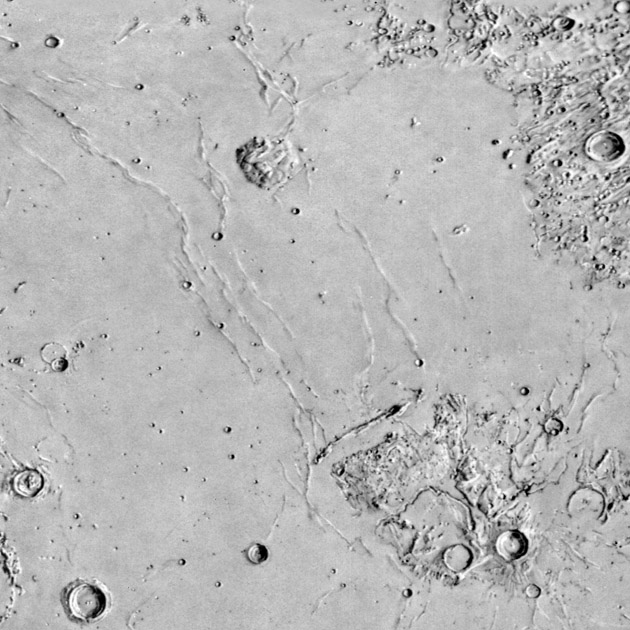December 25, 2017
Outrageous Idea
Originally published June 26, 2008

shaded relief map from USGS Map-A-Planet
Crazy ideas come from late nights, a paucity of images, and a feeling that the Moon may be weirder than we know. Here is the latest crazy idea. The Aristarchus Plateau (bottom right) is a unique lunar feature - it is a large plateau with a huge volcanic vent (Schröter's Valley) - and no ready explanation. I've always felt that it is probably an uplifted chunk of crust. But note the parallel mare ridges to the northwest of the Plateau - they are parallel to and aligned with the edges of the Plateau. Unlike most mare ridges these are not concentric to a basin rim. Should we speculate that the ridges mark the trail of a Plateau that moved 400-500 km to its present position? We have something very similar on Earth. The 90 East Ridge and the Maldives Ridge mark the trail of India's movement thousands of kilometers northward across the Indian Ocean. Is the Aristarchus Plateau the equivalent to India with its massive outpouring of Deccan Traps basalts? This analogue seems poor because the Moon did not have plate tectonics, and the Traps are related to India slamming into the Asian continent. Although there is no evidence for lunar plate tectonics, it is very likely that segments of the Apennine moved laterally, and it has been proposed that the long piece of bright land holding Plato and the Sinus Iridum slid to its present position. So some parts of the lunar crust probably did move, and Schroter's Valley is a uniquely large volcanic source area. Crazy idea.
Chuck Wood
Related Links
Rükl plate 8
Yesterday's LPOD: A New Rille?
Tomorrow's LPOD: The Coming Death of LPOD
COMMENTS
1. The shaded relief map provides an interesting perspective--especially when combined with Apollo mission photos of the Aristarchus Plateau and the Rumker Hills in the distance.
Are there any theories on the origin of the Agricola Mountains? They seem to be separate from the Aristarchus Plateau. (??)
--Bill
2. If the moon was a molten sphere couldn't plates have formed as it cooled? Like the skin on hot pudding. I have always wondered about plate tectonics and if there is some size limit. Like a body has to be so big for them to form. Or is it just an internal heat thing? --- Andrew Martin SFO
3. Isn't the whole region around the Arictarchus Plateau (AR) volcanically related anyway; with an imaginary line linking Mons Rumker in the NW (small clump seen here at top of picture) and the Marius Hills volcanic complex (not in picture) in the SW -- both, roughly, 400 km distance away from AR. I wonder, are we looking here at the lunar equivalent of those hotspot islands (e.g. Iceland, the Azores, and the Galapagos) we see on the Earth linked to mid ocean ridge regions. There may not have been tectonic plates on the Moon to create this proposed volcanic 'hotspot' trio, however, perhaps some weak zone developed in the lunar crust about these regions (created undoubetdly by the huge impactors of Imbrium, Oceanus Proc., or Gargantua???), produced them?
PS. On another note, looks like the South Pole Aitken Basin crater, which held title as being the largest impact crater in the Solar System (~ 2500 km in diam.,) might have a contender as reported yesterday, 25 June. NASA scientists analysing data from both the Mars Reconnaissance Orbiter and the Mars Global Surveyor are reporting an impactor crater coming in at ~ 8500 km across that covers nearly 40 per cent of Mars's surface (called the Borealis basin). John -- www.moonposter.ie
4. Bill - There isn't any good theory for the Agricola Mtns.
Andrew - The Aristarchus Plateau and the mare formed about 600 million years after the Moon's crust solidified. Plate tectonics occurs on Earth and perhaps Europa, two very different places, but both have heat and water, which has been speculated to be a lubricant (in complex chemical ways) for plate movement.
John - Yes, back in the mid-60s a USGS geologist speculated that Rumker, the Plateau and the Marius Hills were along the equivalent of an oceanic spreading center. And they are also along the putative inner ring of the Gargantuan Basin, but this is just speculation piled on speculation. The new Mars giant impact theory is a revival of a 1970s published idea. We have been studying the solar system long enough that its hard to come up with a truly new idea!
-  tychocrater Jun 26, 2008
tychocrater Jun 26, 2008
COMMENTS?
Register, Log in, and join in the comments.



